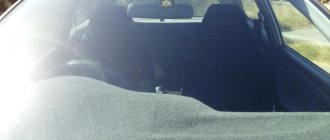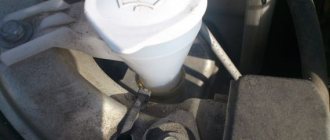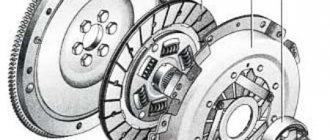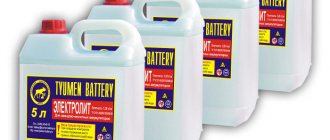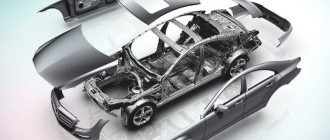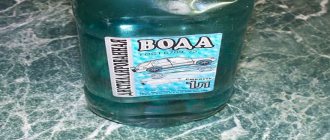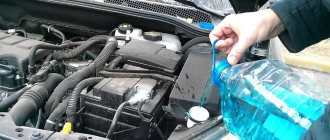To clean the windshield of a car in winter, when the temperature outside often drops below zero, you cannot pour ordinary water into the windshield washer reservoir - it will simply freeze.
In the cold season, car owners traditionally change the water to anti-freeze.
However, some drivers use anti-freeze all year round, and therefore do not worry about sudden changes in weather.
It's easier to buy antifreeze. However, if this is not possible (for example, you went to a remote village where there have never been any auto shops), then there is only one way out - to prepare antifreeze liquid with your own hands.
1
7) Methanol based liquid
Attention!!! Methanol is poison
Therefore, to prepare the anti-freeze recipe we have proposed, it is necessary to exercise careful caution and in no case allow methanol to get into the eyes or respiratory tract. To prepare the liquid you need 1 part methanol and 9 parts water
For example, to prepare 1 liter of anti-freeze you need to take 100 ml of methanol and 900 ml of water
To prepare the liquid, you need 1 part methanol and 9 parts water. For example, to prepare 1 liter of anti-freeze you need to take 100 ml of methanol and 900 ml of water
Therefore, to prepare the anti-freeze recipe we have proposed, it is necessary to exercise careful caution and in no case allow methanol to get into the eyes or respiratory tract. To prepare the liquid you need 1 part methanol and 9 parts water
For example, to prepare 1 liter of anti-freeze, you need to take 100 ml of methanol and 900 ml of water.
To clean the windshield more thoroughly, you can add a tablespoon of powdered dishwashing detergent (for example, Pemolux, Biolan) to the resulting liquid.
Conclusion:
To avoid the risk of damaging your windshield wiper system, always use distilled water in your wiper system. Also remember that poor quality water over time will leave rust and deposits on the windshield wiper nozzles and inside the windshield washer reservoir pump.
If you use purchased windshield wiper fluid in the summer, you can dilute it with distilled water to save money.
To check the quality and reliability of the antifreeze that you made yourself or bought in a store, you need to pour a little liquid into a small container and leave it in the cold for several hours. If the liquid freezes or takes on a gel-like consistency, it is necessary to enhance the anti-freeze properties by adding an alcohol-containing product to it.
Do not keep windshield fluid in open areas at home. It should be stored out of the reach of children. Pets should also not have access to this liquid.
Please note that everything we mentioned above
on the production of non-freezing liquid are taken from open sources of information. Therefore, these methods of preparing antifreeze with your own hands do not guarantee you excellent quality of the product.
Winter, cold weather - you can’t pour regular water into the car washer reservoir - it will freeze. It is precisely for these extreme winter temperatures that the antifreeze liquid was developed. At 10, 15 and even 30 degrees below zero, this liquid makes the windshield clean and streak-free. It's all about the composition of the antifreeze.
The main components of the anti-freeze composition:
- Water.
The main anti-freeze component makes up most of the volume. - Alcohol.
This component is what makes the antifreeze liquid nonfreeze. The more alcohol, the lower the freezing point. Typically the following alcohols are used:
Methyl
– has a low freezing point, low cost, but is poisonous and can cause blindness or death if it enters the human body. Therefore, in Russia, the production of anti-freeze from methyl alcohol is prohibited.
Ethyl
– has no unpleasant odor and is not toxic to humans. True, antifreeze containing ethyl alcohol is almost impossible to find on the shelves due to the high cost of alcohol (not profitable).
Isopropyl
- not poisonous to humans, has an unpleasant odor. This alcohol is mainly used to produce anti-freeze and we must remember that the lower the freezing point of the liquid, the stronger the unpleasant odor will be.
- Coloring and flavorings.
Used to impart a foreign smell, for example, apple, melon, and so on. Accordingly, the dye is used to match the flavoring for apples - green, for melon - yellow. Mainly used for marketing, to attract buyer's attention. - Detergents.
An auxiliary component that improves the cleaning characteristics of the liquid.
Now that you know the composition of the antifreeze, you can easily prepare it at home or even in the garage. In fact, you only need three components.
Tips and tricks
As you can see, if you make an antifreeze with your own hands, the proportions will differ depending on the components that are used. Special attention must be paid to this, and the outside temperature must also be taken into account. For example, if the frosts are severe, then it is better to increase the mass fraction of alcohol in the composition of the washer.
We also add that it is not recommended to use shampoos and shower gels as a fragrance. These products, unlike powders and dishwashing detergents, can foam heavily and leave streaks and marks on the glass. Detergent concentrates are best suited as a cleaner/fragrance added to the washer.
Let us note once again that it is better to use distilled water instead of ordinary water. Otherwise, scale appears in the system, rust may form, deposits may appear on the windshield wiper nozzles, the windshield washer reservoir pump may fail, etc.
We also recommend reading the article on how to do it yourself when washing an engine. From this article you will learn how to wash a car engine, how to properly wash the engine, and what to pay attention to when washing the engine yourself.
After preparing the washer fluid, we recommend checking the frost resistance of the liquid before using it in the car. To do this, just pour a small amount of the finished product into a container and take it outside (you can also put it in the freezer of the refrigerator). If the liquid turns to ice or becomes gel-like, you need to add more alcohol.
Remember, windshield fluid should be stored in a cool place, in a closed container, with access limited to children and animals. This will avoid various emergencies and poisonings.
Another recommendation is that before using a windshield washer (both summer and winter, ready-made or homemade), it is highly advisable to turn on the air recirculation system (if equipped) in the car for a couple of minutes. This will limit the intake of air from outside into the cabin, which reduces the amount of inhaled fumes after using the washer.
Do-it-yourself anti-freeze: preparation rules
- For the composition of a homemade anti-freeze, you can only use good water. Since the water we get from the tap contains many impurities, it is better to purchase purified bottled water, otherwise there is a high probability of leaving streaks and salt accumulations on the car glass. Distilled water is the necessary basis for our future antifreeze liquid.
- It is recommended to make “samples” of windshield washer fluid - after making a small amount, you need to put it in the freezer or on a balcony with a negative temperature in order to test the ability of the composition to withstand frost.
- Before completely filling the windshield washer reservoir, add a little and check that the liquid does not leave streaks on the glass.
- Take care of the smell of anti-freeze! It can get into the cabin, so you shouldn’t let it be too tart or smell unbearably of alcohol.
By the way, all the above tests can be done for a purchased antifreeze to ensure its quality.
Anti-freeze based on window cleaner
Not every window cleaner will work for our purposes, so first make sure it contains alcohol. Our next step will be to maintain the correct proportions - 33% detergent to 67% distilled water. Thus, for a five-liter bottle of water we will need 2.5 liters of detergent and in the end we will get 7.5 liters of non-freezing liquid.
Antifreeze based on ethyl alcohol
“Classic recipe”, which was used by our grandfathers. For the solution we need 3 liters of water and an amount of alcohol, depending on its purity. If the alcohol is 97%, then 650 grams will be enough, 70% -750 grams. If the alcohol has other characteristics, then you can independently calculate the required proportion. At the end, you need to add a tablespoon of washing powder and dissolve it thoroughly in the resulting liquid.
Antifreeze made from vinegar
Another traditional, but less clear-cut option, which is recommended for use at significant sub-zero temperatures below -10 degrees Celsius. The fact is that vinegar has a rather unpleasant odor, and low temperatures dampen it.
The solution is mixed as follows: one part vinegar to one unit of water. Thus, to get 2 liters of non-freezing liquid we need a liter of water and a liter of vinegar.
Ammonia-based non-kneader
If you have access to substantial amounts of ammonia, then you can prepare a fairly high-quality anti-freeze based on it. You need to mix two parts water with one part ammonia, but be careful - foam should not form during mixing, and therefore the shaking method is not suitable for us. Choose a container in which you can mix the components yourself with a spoon, and after that, pour the mixture into a suitable bottle or windshield washer reservoir.
If you have a long journey ahead at very sub-zero temperatures, then the recipe can be improved by adding vinegar - about 100 grams per 3 liters of mixture, and you can fight off the not-so-pleasant smell of ammonia by adding flavorings, but with a minimal chemical base of the latter in order to avoid a reaction.
Anti-freeze from dishwashing detergent
You shouldn’t grab the first dishwashing liquid you come across and put it in the base of our solution - choose a highly concentrated product from a good manufacturer, for example, Fairy. When choosing another product, perform the frost resistance test from the beginning of the article. This option is one of the most budget-friendly, because only one or two spoons of the product will be enough for a five-liter bottle of water.
Antifreeze based on methanol
First of all, it is worth remembering that methanol is a poison, and therefore you need to take all precautions when working with such substances. Getting methanol into the eyes and respiratory tract can result in tragic consequences.
The recipe is as follows: to prepare a liter of windshield washer fluid, 100 ml of methanol will be enough for us. For better glass cleaning results, you can add a spoonful of powdered dishwashing detergent to this mixture and stir thoroughly.
And remember that you can store such liquid at home only out of the reach of children, but it is better not to store it at home at all. We hope our simple recipes will help you avoid getting into a difficult situation when, waking up in the morning, you see negative numbers on the thermometer, but you didn’t bother buying anti-freeze liquid in advance. Now you know how to make an anti-freeze for your car with your own hands!
conclusions
As you can see, making a winter washer with your own hands is very simple, because it is not demanding on the detergent, and “anti-freeze liquids” are freely available. The concentration and formulation must be selected based on the region of operation. Obviously, in the southern regions and the middle zone, options with a 45% share of ethanol are not needed at all, and a decrease in the mass fraction of alcohol will proportionally reduce the cost of the washer. For the northern regions, the vinegar recipe is not suitable at all, but in Moscow and further south it will work very well (subject to the European winter).
However, let's summarize the financial results. The cheapest winter washer up to -30 degrees Celsius with good reviews on Yandex.Market costs about 120 rubles, but this does not include delivery, so we can safely increase the price tag to 170 rubles. The most expensive ones cost 700 rubles, but again we add delivery – 750 rubles. This is the cost of containers for 5 liters.
Our artisanal products received the following cost per 5 liters:
- Based on ethanol – 80 rubles
- Based on isopropyl – 132 rubles
- Vinegar based – 277 rubles
- Based on ammonia - 527.5 rubles
Having set a filter by composition on Yandex.Market, we can safely assume that anti-freeze products up to 300 rubles are based on ethanol, and among products costing more than 300 rubles you can already find products containing isopropyl alcohol. Based on this, the following conclusions can be drawn:
- Yes, making a winter anti-freeze washer with your own hands is profitable, even when compared with the very bottom of the market
- You can use high-quality components (the same isopropyl alcohol) and still win 100% or more of the cost on the market
- Homemade washers without alcohol are expensive and impractical.
It is worth considering some other points regarding the independent production of winter windshield washer fluid for a car - you spend your personal time on its production (anything at all), purchasing ingredients, and at the most you will need to stand in a short line at the store; a product made with our own hands according to our recipe is hypoallergenic and safe for people with relevant health problems.
If you liked and even found this article useful, please add it to your bookmarks and be sure to share it with your friends on social networks, and also rate it with the number of stars it deserves. Any interesting recipes? Share them in the comments!
Description of the store-bought composition of a standard antifreeze liquid
First you need to figure out how this liquid is made, and what is the reason for its stable state in cold weather. If water and fragrances are added to its composition for use in summer, then winter is distinguished by the presence of additional components. Usually, in the production of any anti-freeze, water and alcohol are used, it is the latter that prevents it from freezing at negative temperatures.
You can buy a ready-made anti-freeze or make it yourself
But you should be careful - you cannot take liquids containing methanol, because it is prohibited by law due to the danger of poisoning with toxic fumes. Some unscrupulous manufacturers add this ingredient. This can be determined by the absence of any odor from the antifreeze.
The most optimal anti-freeze component is ethyl alcohol, which is the basis of many wine and vodka products. However, this substance is subject to a high excise tax, as a result of which such a liquid would cost incredible amounts of money. Therefore, it would be much more profitable and easier to use regular vodka mixed with water.
Its fumes can also harm not only the driver, but also the environment.
Most often, isopropyl alcohol is used in the production of washer fluid, which can be found in almost any anti-freeze store. This ingredient is more expensive than the substances described above, however, it does not cause as many harmful fumes. The strong smell of acetone indicates that the antifreeze was made from isopropyl.
Store-bought anti-freeze, in addition to its main components - alcohol and water, may contain ethylene glycol, various surfactants, fragrances and dyes.
The antifreeze composition is indicated on each package
The composition of the antifreeze for cars and the proportions of the components will be as follows:
- From 25 to 75% - this is the percentage of alcohol in anti-freeze products. It is directly dependent on the ambient temperature while the car is moving. At -30 and -35 degrees, its share should reach 75% in order for the anti-freeze to be in a liquid state.
- Water. The absence of impurities in it is a prerequisite. In this form, the manufacturer guarantees the output is a high-quality solution that does not leave streaks or residue after washing. The proportion of its content can vary from 22 to 72%.
- Surfactants added to anti-freeze can be up to 1%, and dyes - 0.001%. The content of other ingredients is 0.5-0.8% in the total amount of this liquid.
Often, drivers purchase the necessary ingredients and prepare a good product themselves. If you know how to mix all the components correctly and in what proportion, then independently producing this product will not be difficult. How to make your own antifreeze at home will be discussed below.
The market is filled with goods from various manufacturers who are not always clean and may sell a low-quality product. Therefore, purchasing anti-freeze liquid in a store does not always seem to be a wise decision. In addition, a poorly made solution can be harmful to health.
Antifreeze based on isopropyl alcohol
To independently prepare 1 kg of winter wash that will withstand frosts of -30 degrees Celsius, from isopropyl alcohol you will need:
- Isopropyl alcohol – 680 grams
- Water – 320 grams
- Surfactant – 20 grams
- Fragrance and dye - optional
The manufacturing process is similar, but, as you can see, we need 51.1% more of the most expensive product! Everything else is the same as in the case of the first recipe.
Total: 68*0.31+32*0.03+2*2=26.04 rubles.
How to make an antifreeze with your own hands
So, about the methods, compositions and proportions.
It should be recognized that all these “handmade” options are more likely to be suitable only in critical situations (as an exception) - when you can’t buy anti-freeze, but you need to go.
Method 1: Alcohol-based window cleaner
The easiest way to make an “anti-freeze” yourself is to use an alcohol-based glass cleaner as a base.
The advantage is that it already contains the necessary additives that provide good cleaning properties. This product is diluted with water in a ratio of 2 to 1 (that is, 2 parts water to 1 part liquid).
Among the disadvantages, it is worth noting the rather high cost of such a home solution, as well as the fact that the liquid made in this way will not last in severe frost (below minus 10 degrees).
Method 2: from vinegar
A simple “anti-freeze” can be made by mixing water and 9% acetic acid in a one-to-one ratio.
The method is quite cheap, but is only suitable for use in the temperature range from minus 10 to minus 20 degrees Celsius.
If it is warmer outside than minus 10, such a liquid will give a very unpleasant odor in the cabin, if it is lower than minus 20, it will freeze.
Method 3: from ammonia
Do you have aqueous ammonia on hand? It can be mixed with water in a ratio of 2 to 1 (2 parts water to 1 part ammonia) and get an “anti-freeze” for use in mild frosts.
To make such a liquid more frost-resistant, you can add a tenth of vinegar essence (that is, for example, 100 ml of vinegar per 1 liter of finished liquid).
Method 4: from vodka or alcohol
And, finally, a method that will guarantee a high-quality “anti-freeze” that is safe for the driver’s health and with the required frost resistance.
You'll have to tinker a little more.
The base for the liquid will be ethyl alcohol (or vodka). It is sold in five-liter canisters and at the time of writing this article costs from 900 rubles for 5 liters.
If you take 2 liters of such alcohol and 3 liters of water, you will get a liquid that can withstand frost of at least minus 15 degrees Celsius.
That is, from a five-liter canister of alcohol you will get more than 12 liters of “anti-freeze”, designed for “average” frosts, or much more if the weather conditions are not so severe.
Proportions
Here are the proportions for obtaining the required frost resistance for a homemade “anti-freeze” made from alcohol (vodka).
| Temperature, degrees C. | Water content, % |
| —1 | 97 |
| —5 | 88 |
| —10 | 79 |
| —16 | 72 |
| —23 | 64 |
| —29 | 57 |
| —33 | 49 |
| —41 | 37 |
| —51 | 16 |
You can tint such a finished liquid by adding regular blue.
It needs to be added gradually, stirring the solution until you get a liquid of the color you want
From the point of view of cleaning abilities and other things, this is not important, the moment is purely aesthetic
What are the disadvantages of this method?
First of all, the smell. It is simply impossible to get rid of the persistent vodka smell in the cabin if the car is not equipped with effective cabin filters.
The second is cost. It is very close to the cost of high-quality branded antifreeze liquids for windshield washer fluids.
So the method can be relevant only in conditions where there is no normal “anti-freeze” on sale or there are great doubts about its originality and quality.
You can really save money and get a liquid with the required frost resistance only by using methyl alcohol as a base, but this option is not considered due to the high toxicity of such a liquid and its vapors.
Bottom line: saving significant money on antifreeze and getting a good result seems very doubtful.
The range of ready-made liquids in stores is very extensive; you can purchase “anti-freeze” with the required frost resistance rating, without the risk of ruining the liquid supply system for the windows and headlights, without having to endure the disgusting smell in the cabin.
However, situations are different
In case of emergency, you can prepare an “anti-freeze” with your own hands, not forgetting about safety precautions and the health of yourself and your passengers.
Video - do-it-yourself anti-freeze made from vodka:
May be of interest:
Choose a DVR: an indispensable gadget for the driver
Scanner for self-diagnosis of a car
Gifts for car enthusiasts - what to choose?
Some drivers prefer a DVR in the form of a mirror
DIY winter wash made with vinegar
Please note that I used the word “washer” and not “anti-freeze”. The fact is that vinegar with a concentration of 6, 9 and 12% is freely available, and it freezes at temperatures of -2, -3 and -4 degrees Celsius, respectively. Obviously, if we mix it with water, we will not get a quality product. Yes, perhaps at -5 it will still “live”, but you shouldn’t count on serious temperatures.
Even to maintain a liquid state at a temperature of -5 degrees Celsius, a 1:1 solution is required, that is, 500 grams of 12% vinegar per 500 grams of water. If you get 70% or 90% vinegar, even with this concentration, the maximum you can count on is -10 degrees Celsius. Of course, you can add more vinegar, but then both you and the car will smell of this sour aroma. The rubber bands and paintwork of a car will also not last long under such use.
Total: 35 (this is how much the cheapest 12% vinegar in a 500 ml container costs) + 1.5 + 4 = 55.5 rubles.
How to make anti-freeze at home
Many topics on car enthusiast forums are devoted to recipes for preparing windshield washer fluid. This solution is not recommended by car manufacturers, but in most cases, a properly prepared anti-freeze product can replace a similar purchased product.
Having highlighted the main cooking recipes, you can focus on the information provided. Car enthusiasts make anti-freeze quickly with their own hands.
DIY anti-freeze made from alcohol
Such a recipe can safely be considered a “classic”, because it was used back in the days when many car owners had not even heard of a special fluid for the washer reservoir. It’s easy to prepare; just mix medical alcohol with pre-purified water (ideally distilled). The proportions directly depend on the “strength” of the alcohol.
How to mix:
- Alcohol 97% is taken at the rate of 650 ml per 3 liters of water.
- You need to take more alcohol of 70% concentration - 750 ml per 3 liters of water.
Cleaning abilities and odor elimination are ensured by adding a handful of washing powder to the prepared solution. Before pouring into the tank, stir the mixture well until the grains are completely dissolved. Homemade antifreeze is ready!
Anti-freeze made from vodka
Many car enthusiasts practice using inexpensive vodka to clean glass. The ethyl alcohol contained in it does not freeze in the cold and performs its function perfectly. Such a recipe is fraught with additional difficulties: a persistent smell of fumes in the cabin and damage to rubber seals upon direct contact with liquid. This can be avoided by using less concentrated formulations and additional flavoring. Antifreeze is often used in such mixtures. It is added at the rate of 1 cm³ for every degree below zero. For five liters of the finished solution this will be 300 ml of antifreeze. A similar mixture is used at ambient temperatures down to -20 degrees.
Anti-freeze from glass cleaner
A good option for non-freezing liquid can be obtained from ordinary glass cleaner. It is necessary to choose a high-quality alcohol-based solution. What remains to be done is to mix it in a 1:2 ratio with water. For 1 liter of antifreeze you need to mix 1 part of the product and two waters.
Antifreeze from fairies
A simple and cheap option is made from dishwashing detergent. To do this, you need to take only 1.5 tablespoons of concentrated product per 5 liters of water. The quality of the finished solution directly depends on the chosen brand
It is also important not to use such compositions at temperatures outside the window below 10 degrees below zero. To prevent the liquid from freezing at low temperatures, alcohol must be added to the composition.
An important nuance: you can test the “durability” of the antifreeze at home. To do this, you can take some of the liquid out onto the balcony and check the temperature drop at night. A good solution should not freeze or precipitate. If this happens, it is unsafe to use such mixtures for your car.
Antifreeze liquid made from isopropyl alcohol
If you have isopropyl alcohol, you can prepare an almost “branded” anti-freeze. It will consist of alcohol, water and detergent. Traditionally, alcohol and water are diluted in a 1:1 ratio, and detergent is added and diluted at the rate of 1 - 2 tbsp per 3 liters of the resulting mixture. The resulting solution is used at temperatures down to -20 degrees. The use of a liquid that can withstand much more severe frosts requires an increase in the percentage of alcohol.
Alcohol-containing washer fluid
Winter washer fluids of this type are divided according to the type of alcohol they contain:
- Based on methyl alcohol. This category is prohibited by law, as it has increased toxicity and, as a result, is very dangerous to health. But, despite all this, it is often used by unscrupulous manufacturers due to the low cost of the main raw materials;
- Using ethyl. It is also the raw material for the production of the “famous” drink. Making anti-freeze bags from it is the most expensive and therefore occurs infrequently;
- Manufactured using isopropyl alcohol. The most common component used in the production of goods of this class. It has a pungent odor that resembles acetone. It has a negative effect on the human body only when ingested. Doesn't have a good effect on the car's finish.
Now we have gradually approached the question of how to make anti-freeze.
Based on all the positive and negative qualities of the liquids considered, we will not risk our health and the health of our passengers (children may be among them). And we will begin to make our windshield wiper from ethyl alcohol, familiar to everyone. I can disappoint those who love saving - this will not be the cheapest option. For this we need:
- Ethyl alcohol used in medicine. You can buy it in online stores with delivery straight to your door. And it is sold in various volumes, from small to twenty-liter canisters.
- Water. Distilled is better, but if you don’t have one, you can use water passed through an ordinary filter.
- Any detergent, for example, the one used for washing dishes. There are no restrictions here, you can use what you have available.
- Well, you can use a flavoring agent to add flavor.
Mix water and ethyl alcohol in the percentage required to obtain an antifreeze liquid to the temperature you need:
| Alcohol % | Required temperature |
| 11,3 | -5,00 |
| 20,3 | -10,6 |
| 22,1 | -12,2 |
| 26,7 | -16 |
| 33,8 | -23,6 |
| 46,3 | -33,9 |
| 56,1 | -41 |
| 71,9 | -51,3 |
After mixing, add detergent at the rate of one tablespoon per three-liter bottle of the mixture and give it all a scent with a fragrance.
How to choose the right antifreeze liquid
Antifreeze is a liquid based on water and alcohol, and the higher the content of the latter in the solution, the lower temperature it becomes (at 50% content it can withstand temperatures down to -30C). In severe frosts, therefore, liquid concentrate should be poured into the washer reservoir, and at -5-10C you can dilute the anti-freeze with water.
Today there are many windshield washer fluids on the market from various foreign and domestic manufacturers, with different chemical compositions and conditions of use. How not to make a mistake with your choice, buy an anti-freeze product with the required crystallization limit (freezing temperature) and not stumble upon a counterfeit product?
Read the labels on windshield washer fluid containers! It should indicate:
- crystallization (freezing) temperature – from trusted manufacturers on the packaging it is indicated for the concentrate with a margin of several degrees;
- kinematic viscosity - fluid fluidity and thickening conditions (thickened antifreeze clogs the nozzles);
- surface tension coefficient - the ability of a liquid to wet surfaces and impregnate dirt (the higher the better);
- surfactant content (surfactants) – the less, the better.
A separate and very important characteristic is the type of alcohol used in the solution. Ethyl alcohol is considered the highest quality and most expensive, the most popular is inexpensive and effective isopropyl alcohol, the most dangerous to human health and prohibited in legal production is methyl (methanol).
Counterfeit anti-freeze products are easy to identify: if they have no odor, they are dangerous and toxic methanol. If the smell is very strong and unpleasant, it is also a counterfeit product with “flavoring” additives. Ethanol antifreeze smells like vodka, isopropyl liquid has a slight smell of acetone. At the time of buying. Check liquids for smell!
Advice: even if you bought a well-known brand of anti-freeze (for example, Hi-Gear, Liqui Moly, Effect Plus, “Clean Mile”, etc.), and the seller is reliable, do not rush to fill the washer reservoir full! Firstly, today it is easy to stumble upon counterfeit liquids, and secondly, there is no guarantee that you have not made a mistake with the freezing temperature. First fill in 1-1.5 liters - in case of an error, it will not be difficult to drain them later.
Ethanol
For harsh climatic conditions, a composition based on ethyl alcohol will be effective. The price of the base component is much higher compared to isopropyl, but the freezing threshold is different, about minus 500 degrees.
To prepare anti-freeze, you need to mix the ingredients in the following proportions:
- 30% alcohol;
- 70% water;
- 5 g detergent.
In this recipe you need a little less surfactants, since ethyl compounds do not allow them to freeze even in severe frost
It is important not to overdo it with foaming substances. If there are too many of them, streaks cannot be avoided on the car glass.
On a note!
Economically, producing such an anti-freeze product at home is not profitable. However, only such a composition can withstand temperatures below -40 degrees, so residents of the northern regions should make a high-quality antifreeze at home.
Ethyl alcohol is often counterfeited
Therefore, it is important to check the mixture before filling the tank. It is exposed to the cold for 8 hours
A sign of heat resistance will be the absence of crystals and an unchanged liquid consistency. The antifreeze should not turn into a thick gel.
Pros and cons of home “anti-freeze”
The advantages of using a homemade antifreeze are as follows:
- the composition of the liquid is known, which eliminates the possibility of poisoning by methanol vapors;
- the product based on ethyl alcohol has high quality characteristics, does not damage surfaces or parts and is not toxic;
- The aroma is chosen at will and will not be intrusive.
As disadvantages it should be noted:
- a high-quality product based on ethyl alcohol has a high cost - at least 250 rubles. for 1 liter;
- some detergents or washing powder may leave streaks on the glass;
- certain substances in surfactants can negatively affect the paintwork of a car and destroy rubber and plastic parts;
- time costs for manufacturing the product;
- Anti-freeze based on ethanol and isopropyl alcohol has a pronounced alcoholic odor, which can lead to driver intoxication when inhaling vapors in the cabin. If you are stopped by traffic cops, you will most likely be asked to undergo a medical examination for alcohol consumption.
It should be remembered that allergic reactions in humans can occur both when using a purchased product and a homemade one.
Making “anti-freeze” with your own hands is quite simple - the recipes are time-tested and their effectiveness has been proven. You won’t be able to save money, but using high-quality washer fluid will offset the costs.
How to fill with anti-freeze?
First you need to open the hood of the car. Then find the glass washer reservoir and unscrew the cap. The mixture is poured into the neck; for convenience, you can use a watering can.
- Turbo timer for diesel - what is it for and how to install it yourself (video + 105 photos)
- Which gasoline is better to fill in - tips on how not to harm the engine with low-quality fuel (video and 110 photos)
- Battery charger - how to choose the best chargers. How to properly charge the battery with your own hands (125 photos)
You need to fill the liquid depending on the weather conditions. If the forecast expects sub-zero temperatures, then it is best to fill in the anti-freeze immediately. If frosts are mild, the liquid can be diluted with distilled water.
How to prepare anti-freeze
It makes sense to start producing a low-temperature windshield wiper for your car if you have to constantly operate your car in harsh winter climates. Producing your own liquid will allow you to save a lot on the purchase of a factory-made, high-quality anti-freeze and guarantee to get a mixture that will not freeze “suddenly” and will give a good cleansing effect.
There are several simple and inexpensive ways to prepare windshield wiper fluid:
With ethyl alcohol/vodka
Ideally, of course, it is better to use inexpensive isopropyl alcohol, but it is not always on hand. Instead, you can mix water with alcohol or vodka. To do this, just add three glasses of medical or drinking alcohol to a five-liter bottle of water. If it is already diluted to 70%, you can add 4 cups and add one tablespoon of regular laundry detergent. Keep in mind: the lower the density of the alcohol, the greater its proportion in the water should be so that the mixture does not thicken and freeze at -25C.
With vinegar
Vinegar also prevents windshield cleaning fluid from freezing at temperatures down to -10C. To prepare the mixture, add acetic acid to water in a 1:1 ratio. In severe frosts, it is better not to use acetic acid, or you should add another glass of vinegar to the liquid. The main problem is the pungent odor - the higher the vinegar content in the water, the stronger it will be felt in the cabin.
Read with this
- Specific vaporization of water: formula, physics of the process
- Antifreeze colors
- How to clean a boiler yourself at home
- What should I put into the heating system of a private home?
- Radiator cap: device and possible malfunctions
- Making a fireplace out of boxes for the New Year with your own hands
- Is it worth it and is it possible to store a bicycle on the balcony in winter: advantages and consequences
- Even more opportunities for relaxation! building a Russian stove on the street with your own hands: diagram and instructions
- What and how to cover the stove so that it does not crack from the heat?
- Fasteners for walls made of cellular and hollow material
Conventional anti-freeze formulations
If in the summer composition of windshield wiper fluid everything is more or less simple - it is water and fragrances, then in the winter composition of anti-freeze there are many nuances. Typically the composition is made on the basis of ethyl or isopropyl or methyl alcohol.
In those countries where control over alcohol-containing products is not so strict, ethyl alcohol is often used. But the negative impact of this type of alcohol on humans and the environment has forced companies producing cleaning fluid to switch to more expensive isopropyl alcohol. This type of alcohol does not produce as much evaporation as ethyl alcohol, so the harmful effects are minimized as much as possible.
